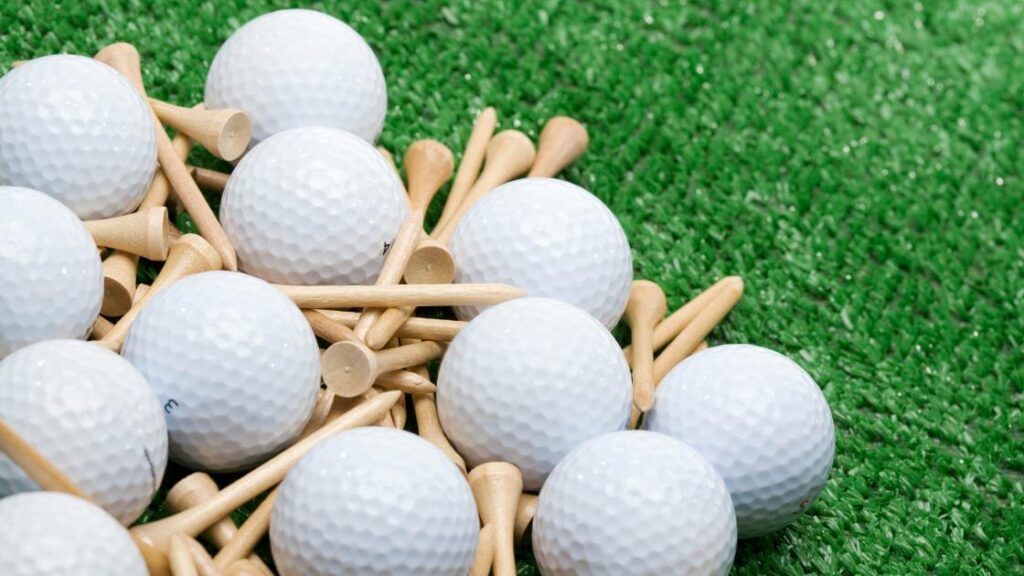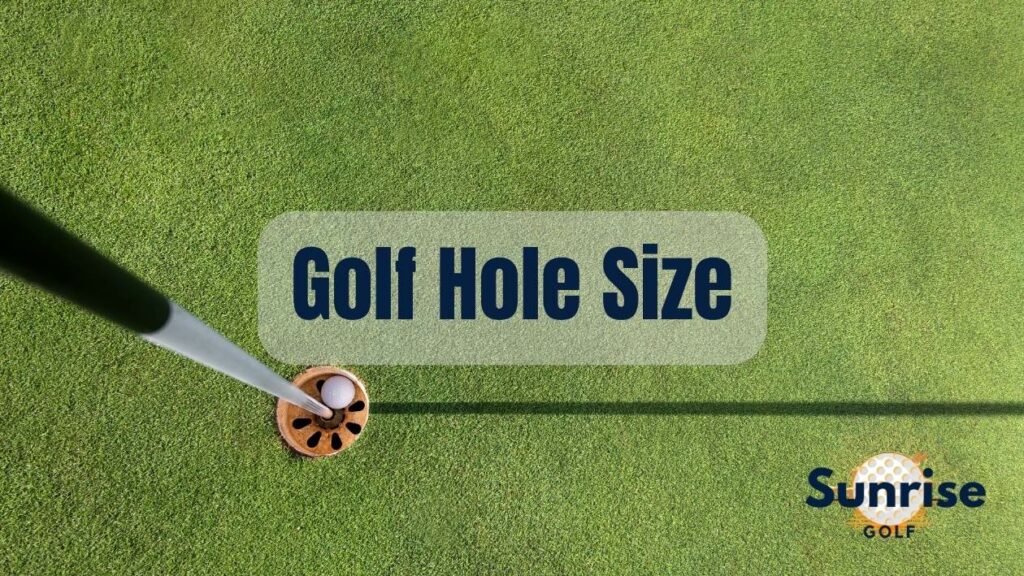Ever wondered why the diameter of a golf ball matters so much? The size of these dimpled spheres, or the “diameter of golf ball”, plays a crucial role in their flight, spin, and control, impacting your overall performance on the course. In this comprehensive guide, we’ll delve into the importance of golf ball diameter, its history, regulations, and how it affects your game. Ready to elevate your golf knowledge? Let’s get started!
Understanding Golf Ball Diameter

The flight, spin, and reaction of a golf ball when it strikes the clubface are largely determined by its diameter and weight. The standard golf ball dimensions help maximize ball speed, distance, and spin rate, ensuring optimal performance for golfers. Governing bodies like the United States Golf Association (USGA) and R&A establish golf ball diameter regulations, which manufacturers must adhere to. USGA regulations stipulate that the standard golf ball size should be approximately 42.7 millimeters or 1.68 inches in diameter.
The weight of a golf ball for tournament play is restricted to 1.62 ounces, which makes many golfers wonder, “how much does a golf ball weigh?” This equals approximately 45.93 grams. Regulation golf balls must be round and come in various constructions such as two-piece, three-piece, and multi-layer golf balls. Depending on the golfer’s skill level and swing speed, they may opt for low compression balls, which are softer and more forgiving, or high compression balls that are harder and better suited for faster swings. Understanding golf ball weight can help golfers make the right choice for their game.
The History of Golf Ball Sizes
Golf ball sizes have significantly evolved from the early wooden and feather-filled balls to the modern standardized sizes we use today. The featherie golf ball, made of feathers and a leather outer layer, was eventually replaced by the guttie golf ball, made from the dry sap of the Malaysian sapodilla tree;. The guttie was easier and cheaper to produce and could be reshaped if damaged.
In the past, golfers had to choose between the larger American golf ball (1.68 inches in diameter) and the smaller british golf ball (1.62 inches in diameter). However, the smaller British ball was banned by the R&A in 1990, and the standard golf ball size was set at 1.68 inches for both the USGA and R&A.
Dimples on a golf ball, potentially numbering up to 500, significantly contribute to generating a predictable ball flight.
Golf Ball Diameter Regulations
The USGA and R&A set golf ball diameter regulations to ensure fairness and consistency in the game. In competitions, golf balls must have a minimum diameter of 1.68 inches and a maximum weight of 1.62 ounces.
While larger golf balls are permitted, any that exceed the specified dimensions and weight may lead to disqualification from tournaments.
How Diameter Affects Golf Ball Performance
Golf ball compression is a critical aspect of golf ball performance, as it measures how much the ball compresses when hit by the clubhead. Compression ratings range from 30 to 120, with lower ratings indicating a softer ball, more suited for golfers with slower swing speeds.
The flight and distance of a golf ball are also significantly influenced by the dimples on its surface, most of which have 500 or fewer dimples.
Flight and Distance
Despite popular belief, the diameter of a golf ball doesn’t have a significant impact on its flight and distance. Instead, the dimples on the ball’s surface create a thin layer of air around the ball, reducing air resistance and allowing it to travel further. The dimple pattern affects drag, increasing the ball’s speed while in the air.
A softer golf ball, typically with a lower compression rating, allows golfers with slower swing speeds to transfer more energy from their clubface to the ball, providing greater distance;.
Spin and Control
Experienced players seeking precision in their game may find smaller golf balls to be ideal as they usually offer more spin and control. Soft golf balls provide more spin, allowing for better control on approach shots and short game play.
However, softer golf balls tend to be more expensive than their harder counterparts. Golfers with less power behind their swing, such as those with lower swing speeds, can benefit from the added distance provided by softer balls.
Types of Golf Balls and Their Diameters
A variety of modern golf balls are available on the market, including a few golf balls with unique design, construction, and golf ball volume, produced by various golf ball manufacturers to enhance your performance at each golf hole.
Two-piece, three-piece, and multi-layer golf balls are the most common, all with a standard diameter of 1.68 inches.
Two-Piece Golf Balls
Featuring a small core and a shell, two-piece golf balls maintain the standard diameter of 1.68 inches, making them a smaller golf ball option. These balls are designed for higher handicap or beginner golfers seeking more distance than feel and control.
Two-piece golf balls are typically the most affordable option and have a tough outer layer made of Surlyn;.
Three-Piece Golf Balls
With a standard diameter of 1.68 inches, three-piece golf balls provide a better feel and spin for mid-handicap players. The outer cover is usually made of Urethane, providing enhanced control and spin capabilities compared to two-piece balls.
This makes three-piece golf balls ideal for mid-handicap players who want to
Multi-Layer Golf Balls
Adhering to the standard diameter of 1.68 inches, multi layer golf balls offer a superior combination of distance, control, and spin for advanced players. The intricate inner layers work with the clubface when the multi layer golf ball is hit, imparting unique flight characteristics and offering optimal performance for experienced players.
Choosing the Right Golf Ball Diameter for Your Game
Consider factors such as your swing speed, skill level, and course conditions when selecting the appropriate golf ball size. Think about the types of courses you typically play on and your swing speed when choosing golf balls.
For example, using a larger golf ball for putting practice can simplify putting with a standard-sized ball during actual play.
Non-Standard Golf Ball Sizes
Non-standard sizes, including the undersized Zeus Impact golf balls, exist even though the standard golf ball size is 1.68 inches in diameter. Using non-standard golf ball sizes can offer potential benefits for practice or recreational play, but be aware of the rules and regulations when participating in official tournaments and competitions;.
Golf Ball Diameter Myths and Misconceptions
Golf ball diameter is surrounded by several myths and misconceptions, including the belief that larger golf balls can travel further, that smaller golf balls are illegal, and that the diameter of a golf ball influences its spin. In reality, the size of a golf ball does not significantly impact its distance, there is no minimum size requirement for golf balls, and larger golf ball diameters generally result in more backspin.
However, the size of a golf ball does have an effect on the feel of the ball when
Summary
We’ve explored the importance of golf ball diameter, its history, regulations, and impact on performance. Understanding these aspects can help you make informed decisions about your golf equipment, ultimately improving your game. Remember, choosing the right golf ball size for your skill level and swing speed is essential, so take the time to find the perfect fit and watch your game soar!
Frequently Asked Questions
What is diameter of a golf ball?
The diameter of a golf ball must be at least 42.7mm (1.680 inches).
How many golf balls fit in a 747?
23.5 million golf balls can fit in a 747, given the diameter of the ball is 40mm.
Why are there dimples on a golf ball?
Golf balls have dimples which reduce air drag, allowing the ball to travel further. The dimples create small indentations on the surface, vibrating the air around the ball when it is in the air.
How does golf ball diameter affect performance?
Golf ball diameter can significantly impact performance as it affects flight, distance, spin, and control.
Are non-standard golf ball sizes allowed?
Non-standard golf ball sizes are allowed for recreational and practice play, but may not be permitted in official tournaments and competitions.

